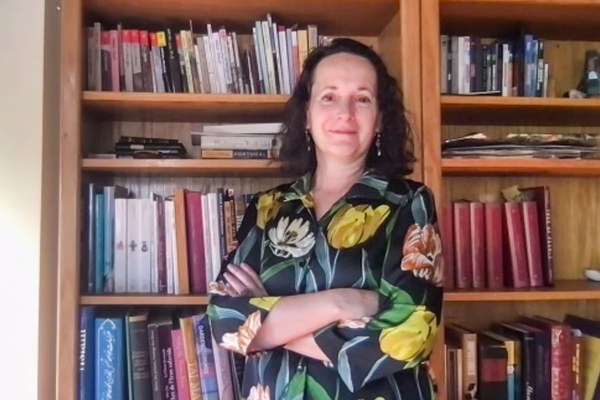Mika Natif, associate professor of art history at the George Washington University, is a fellow in Garden and Landscape Studies. Her research report, “Mughal Women in Gardens: Patrons, Users, and Designer” proposed reconsidering the agency of women in Mughal history through their depictions in gardens, such as Hamida Banu in the Akbarnama.
Q&A with Mika Natif
Who was Hamida Banu, and how does she help us understand the relationship between Mughal women and gardens?
Hamida Banu lived in what is now Afghanistan, Pakistan, and northern India between 1525 and 1604. She was married to the second Mughal emperor, Humayun, and the mother of the more famous third Mughal emperor, Akbar, becoming the most powerful Mughal female figure during his reign. I was studying portraits of Mughal women and noticed portraits of Hamida Banu and other women, royal and otherwise, were often set in gardens. The Mughals maintained a seminomadic lifestyle, and gardens served as a place for the court to hold public events and private celebrations. The garden was not connected to anything feminine or to female patronage specifically; it was something all aristocrats or royals had and used as a way to mark territories of a growing empire and was also a potential source of agricultural and economic prosperity. But the prevalence of portraits of Mughal women in gardens suggests it was also a setting for women to express their authority and more public persona, too—a way to indicate their political or economic impact and function in society, whether as musicians, attendants, or royalty.
How is this represented in manuscripts like the Akbarnama?
The Akbarnama is the official chronicle of Akbar’s reign, written by his vizier and close confidant, Abu’l Fazl. Abu’l Fazl did not witness most of the early events, so his account offers a glimpse into what Akbar’s court—which would have included Hamida Banu—wanted to project about the empire. I am looking at a copy of the text that Linda York Leach has argued was produced specifically for Hamida Banu, based on the presence of several unusual paintings and a certain type of script. Importantly, illustrations in a text did not necessarily reflect reality, or even reflect the text they appeared in, and would have been expected to reflect the patron who commissioned it.
One of the more unusual paintings depicts the celebrations of Hamida’s marriage to Humayun. The Akbarnama text has just one sentence about the imperial wedding—imagine if there had been just one sentence about Charles and Diana getting married in the newspaper—but the painting is resplendent with trees, flowers, and festivities. They were married in 1541, when Humayun was in a very bad position: he had lost most of his territories and was evading his rivals by moving from one place to another. Humayun had to persuade Hamida Banu to marry him—she had initially stated intentions to marry a man she could control—and the wedding took place without the usual imperial resources. They celebrated for about three days at the camp of Humayun’s half-brother—not even their own home, and certainly nothing fancy.
Abu’l Fazl glosses over this event in the text, mentioning only the year of the wedding, not even which month. But the painting in this copy of the manuscript shows pomegranates, blooming oleander flowers, and other botanical bounties in great detail, which helps place the event in late summer or early fall. Based on other historical accounts, this image suggests the wedding is being depicted in the garden of Humayun’s foster mother, Dildar. The painting and the women connected with it then have a very strong female presence: Humayun’s foster mother is hosting an event marking the beginning of Hamida Banu’s ascent to power through the birth of Akbar. The painting becomes a depiction of the transition of power from the senior Mughal female figure—Dildar—to Hamida Banu.
Why is it important to understand these depictions?
Portraits of Mughal women have not been seriously considered in art historical writing, and I think looking at the role of Mughal women in this way will seriously change the narrative of Mughal art historical discourse. We can no longer talk only about a patriarchal historical identity because we actually do have portraits of Hamida Banu, Gulbadan, Dildar, and many other powerful women. But we have to start looking, because the history has been “male-washed”—women have been completely ignored, not because they’re not there but because we’ve been asking the wrong questions. I do not want to offer an alternative history: I want to change the current narrative to be much more diverse and complex than scholars have previously wanted to depict it. The expertise of people like Dede Ruggles, Arijit Sen, [Resident Program Director for Garden and Landscape Studies] Thaïsa Way, and [Curator of Rare Books] Anatole Tchikine has been very helpful in thinking about how to write histories of people who have been written out of history, and in helping me identify plants and the significance of the structure of the gardens.
May Wang is postgraduate writing and reporting fellow at Dumbarton Oaks. Photo by Richard Tong, postgraduate digital media fellow.

